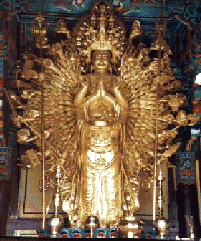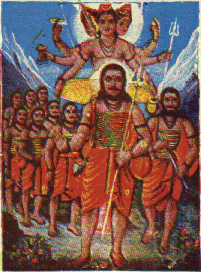


Yoga and the Nath Sampradaya
The success of this (Natha) sect was partly due to the fact that its teachers did not recognise caste barriers, and their teachings were adopted by outcastes and kings alike." - Encyclopedic Dictionary of Yoga, Georg Feuerstein.The heterodox Natha tradition has many sub-sects but all honour Gorakhnath and Matsyendranath as their originators. Here you will find original material, translations and other works relating to this pan-Indian tradition.
The Nathas are believed to be the descendants of earlier cults including the Pashupatas, Kapalikas and Siddhas. They were also intimately connected with the alchemical tradition of Rasayana. There is much more information on this site about the Nath tradition.
The Adinatha Tradition. Discover more about the Nath sect of yogis and yoginis. HH Shri Mahendranatha Paramahamsha Dadaji was the 23rd Adiguru of this tradition. The Nathas are still active to this day. See the eight lotus chakra system of the Kaulas.
Kaula Jnana Nirnaya. English translation of chapter three of this important tantra, attributed to Siddha Matsyendranath.
Ecstasy, Equipoise and Eternity. Written by Mahendranath (Dadaji), explores the origins of the Nathas and their relationship to freedom.
Dattatreya. Written by Mahendranath (Dadaji), covers the great guru of the Nathas and includes valuable material on sama, samarasa and pratibha.
The Naked Saints of India. Written by Mahendranath (Dadaji), and covers the ancient tradition of the naked Indian sadhus.
Dadaji Dhuniwala. Another article by Mahendranath (Dadaji); a fascinating account of Indian sadhu life.
 The Yoga Vishaya. Attributed to Minanath (Matsyendranath),
this short work deals succinctly with guru, disciple, path, chakras and the Hamsa 21,600 mantra.
The Yoga Vishaya. Attributed to Minanath (Matsyendranath),
this short work deals succinctly with guru, disciple, path, chakras and the Hamsa 21,600 mantra.
The Gorakh Shataka. An ancient text of the Natha tradition, written in the form of a dialogue between Gorakh (Gorakshanath) and Macchendra (Matsyendranath).
Analysis of the Siddha Siddhanta Paddhati by Gorakhnath. This is an important work of the Nathas. It covers the different parts of the psycho-physical organism, shows the relationship between the microcosm and the macrocosm, and the importance of the guru to the tradition. Also view here the remarkable story of the current Nepalese one rupee coin and how it connects to the Nath tradition.
Artwork is © Jan Bailey, 1996-2018. Translations are © Mike Magee 1996-2018. Questions or comments to mike.magee@btinternet.com
Home Page